Shipwreck Regia Torpediniera ALTAIR (AT)
-
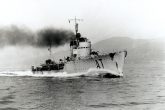
RT ALTAIR (© Archivio Aldo Cherini) -
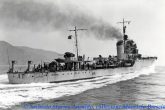
The sister ship of ALDEBARAN, torpedo boat ALTAIR during tests. The ships were twins and were constructed at the same period in Ansaldo shipyard in Genova -
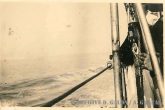
The torpedo boat Altair cruising. -
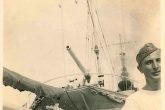
Sailors in the stern of ALTAIR torpedo boat under the 100 mm guns. -
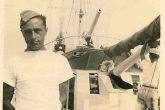
Sailors in the stern of ALTAIR torpedo boat under the 100 mm guns. -
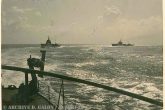
The torpedo boats ALTAIR and ALCIONE. -
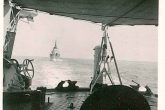
The torpedo boat Altair as can be seen from her sister ship ALDEBARAN. -
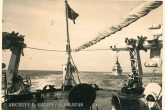
The Altair as can be seen from the stern of the ALDEBARAN. -
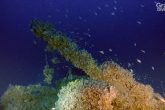
The first stern firearm of 100mm from the side of the bow. Depth 136 meters. -
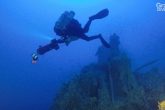
Diver Fontas Pitsinelis near the funnel of ALTAIR. -
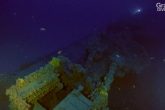
Anti-aircraft guns in the mid ship of ALTAIR. Depth 136 meters -

Video from the shipwreck Altair in depth 144 meters.
Italian Torpedo Boat ALTAIR (AT)
On the 15th of October 2015 the Grafas Diving Team in collaboration with Giannis Mitilinaios and Dimitris Smirniotis, dived a wreck SouthWest of Patroklos islet, which was afterwards identified as the torpedo boat “Altair” (AT), sister ship of the same class ALDEBARAN (AL), which also sunk in the Saronic Gulf and found by the same team on February 2014. The depth of 144 meters and the short bottom time did not, at first, allow the identification of the ship. In 2019, four years later and after serious documentation the wreck was finally confirmed to be the Italian Navy torpedo ship ALTAIR, which was lost at 02.47 on the 20th of October 1941, southwest of Patroklos islet. After confirming the ship was ALTAIR, the research on the Italian torpedo ships that were lost by warfare activities in the Saronic Gulf during the Second World War was completed. That journey began when CURTATONE was found, ALDEBARAN which followed and completed with ALTAIR.
Construction and Technical Specifications
The Italian Royal torpedo boat ALTAIR (RegiaTorpediniera ALTAIR) was a SPICA class, PERSEO type and was identical with the rest of the seven torpedo boats of the same class[1]. All those torpedo boats had been given the names of constellations, like ALTAIR, which is the brightest star of the Eagle constellation (Aquila in latin). ALTAIR’s construction was initiated in Cantiere Ansaldo shipyard, in Sestri Ponente Genova Italy; on the 2th of October 1935 along with her sister ship ALDEBARAN (AL). She was launched on the 26th of July 1936 and was completed on the 23rd of December of the same year.
General Characteristics and specifications of the ship:
Name: ALTAIR
Name Code: AT
Type: Torpedo Boat (Torpediniera)
Nationality: Italian
Core: Regia Marina Italiana
Displacement: Standard, 630 tons / Full Load, 1.020 tons
Length: 82 meters
Width: 8,2 meters
Draught: 2,8 meters
Propulsion: Two steam turbines with 19.000 HP thrust
Propellers: 2
Indicated speed: 34 knots
Autonomy: 1.910 nm with 15knots speed / 1.700 nm with 16 knots / 60nm with a speed of 30 knots
Armour: Three Italian nautical machine guns 100/47 mm., OTOMod type. 1931, eight machine guns 13,2 mm., BredaMod. 31 type, four torpedo tubes of 450 mm., Two deep bomb ditching devices, ability to carry 20 mines, mine gripping harness.
Crew: 119 persons (7 Officers και 112 noncommissioned officers and sailors).
Operations 1937-1941
Just after her completion and her first operational tests in the Tyrrhenian Sea, under the supervision of the ship builder, she was sent to the Italian occupied Dodecanese where she joined the Italian Naval Force of the Aegean Islands (CommandodelleIsoleitalianedell/ Egeo) where she stayed until the summer of 1937. In 1938 she became the leader of the 12th Torpedo Boat squadron (XIISquadrigliaTorpediniere) of Regia Marina Italiana, based in La Maddalena of Sardinia. At first, from June 1940 she was used as a training vessel, based in Augusta Siceli. Two days after Italy joined the Second World war, on the 8th of June 1940, ALTAIR participated in the protection of the coastal cities of Liguria by the bombardment which the French Navy initiated. From August to November, in the same year she participated as a protection element against mine laying and enemy convoys. From the 31st of October until the 1st of November 1940, ALTAIR, along with ALDEBARAN, ANDROMEDA and ANTARES participated in the Special Naval Forces (Forze Navali Speciali) of RegiaMarina, with the objective to prepare the ground for the already programmed invasion in Corfu, Greece. It had been planned for the 47th infantry division, known as “Bari” (47th Divisione Fanteria «Bari») to board the ships and invade Corfu, as a general plan to occupy the mainland through the Ionian Islands. The great losses in the Albanian front though, led to the cancellation of this plan and the transportation of the army on Avlona port in Albania to reinforce the Italian army in the GreekItalian front in Albania. At the same time and on the 29th of December of 1940 in particular, one of the sister ships of ALTAIR, the torpedo ship ANTARES, rammed and sank the Greek submarine Proteus (Cptn M. Hatzikonstantis) with all her crew, in the Adriatic sea, just before PROTEUS had torpedoed and destroyed the troop carrier SARDEGNA. From November 1940 until May 1941, ALTAIR operated in the Adriatic Sea as a companion to the convoys that had the duty to constantly provide the Italian forces in the Albanian front, with men and supplies. On the 4th of May 1941, after the occupation of Greece by the axes forces, ALTAIR, with the torpedo boats ANTARES and ARETUSA, along with the BARLETTA destroyer, transferred the first units of the Italian occupation army to Argostoli Kefallonia, from Brindisi. Following this she joined the 1st Torpedo Boat Squadron (1stSquadrigliaTorpediniere) of Regia Marina in Greece, that was under the command of the recently created North Aegean Italian Naval Commandment «Marisudest» (Comando Gruppo Navaledell’ Egeo Settentrionale. Marisudest was based in Athens and joined the German Kriegsmarine, in all the naval operations in the Greek Seas. ALTAIR until her sinking acted as a convoy escort, firstly in “Operation Hermes” (see Battle of Crete) and then in the entire Hellenic region, from North Aegean to Crete and the Cyrenaica. Until her sinking she participated in 119 missions, covering 22.528 nautical miles.
British submarine HMS RORQUAL (N74)
The cause of sinking of the ALTAIR was her impact on a mine that had been laid by the British mine deploying submarine HMS RORQUAL. This submarine was not only the cause of the sinking of ALTAIR, but also of her sister ship the ALDEBARAN, which also struck a mine of the same minefield, at 08.05 on the 20th of October 1941. HMS RORQUAL had been one of the most successful submarines of the Royal Navy, having destroyed 16 ships. She was built in Vickers Armstrong shipyard, in Barrow in Furness of England, in 1936 the same year ALTAIR and ALDEBARAN were launched and was on the 6 GRAMPUS class subs. In 1940 she was dispatched to the Mediterranean and participated in several campaigns, most of the mine setting missions, until 1945 where she was sent to the Far East to join the allied forces against the Imperial Japanese Navy. After the end of the war the submarine was decommissioned and sold as scrap. In May of 1946 she was dismantled in Newport of Wales. On October 1st 1941, HMS RORQUAL, under the command of Lt. Lennox William Napier RN set course to Alexandria’s East Mediterranean Royal Navy Base, for offensive patrol operations in the Aegean Sea. The following day she rushed to Port Side of Egypt, through the Suez Canal in Bitter Lakes where she settled next to S.S GUMA, in order to load mines. On October 3rd she dispatched and four days later, after crossing through Kithira Canal, she reached the Saronic Gulf with a mission to lay 50 mines west of St. George islet.
The British activity entry logs of the Submarine for 08.10.1941, records the following:
“05:30 Dive close to St. George islet course to the mine laying point.
08:35 Convoy was spotted, consisting of two diesel vessels, accompanied by CURTATONE, a torpedo boat, TURBINE class with a course of 30 degrees, passing close to the north edge of St. George islet. No attack was attempted, due to the mine setting operations. 11.29 The first mine was set at the point 37? 29’ N and 23? 53’ E. At 12:12 the 50th mine was laid.
19:00 surfacing and due south course. Crossing between the islands of Falkonera and Karavi in the Kithira Canal continuing cruising on the surface at night” The deadly trap that caused the sinking of ALTAIR and ALDEBARAN twelve days later, had been set.
Sinking of ALTAIR and ALDEBARAN [2]
On the afternoon of October 19 1941 a convoy [3], consisting of the Italian ships CITTA DI MARSALA CITTA DI AGRIGENTO, TAGLIAMENTO and the German ship SALZBURG, accompanied by the Italian torpedo boats LUPO, ALTAIR, MONZAMBANO and the assistant destroyer BARLETTA, sailed by Piraeus heading towards Heraklion of Crete. At 19:28 and while the convoy was on the west side of St. George islet, an explosion was heard on ALTAIR, which was cruising left of the convoy. ALTAIR (Lit. Cardinalli) was approximately 3 miles away and to the east, bearing 320? off of St. George Islet [4]. The bow was instantly detached from the rest of the ship and sunk. At the same time a fire started on boiler N.1, that was a direct threat to the ammunition holds [5]. The torpedo boat LUPO (Lit. Mimbelli) instantly turned towards ALTAIR. She received a negative response upon demanding to attempt to tow ALTAIR. At around 21:00 and while the fire on ALTAIR had died down LUPO managed to tow the ship using the anchor chain. The captain of LUPO lt. Mimbelli , as a commander of the convoy ordered the rest of the ships to continue their mission to Heraclion and ordered MONZAMBANO and BARLETTA to stay in the area and aid ALTAIR. The constant inflow of water however, made ALTAIR heavier and heavier, coupled with the bad weather made towing almost impossible. The objective of Lt. Mimbelli was to tow ALTAIR towards an area that aiding forces were expected to come after Marisudest’s order. Torpedo boat SELLA was on its way to replace LUPO from this mission. He also had ordered the dispatch of all the towing boats, anti-submarines and diesel vessels to ALTAIR’s location, to aid in the collection of the personnel and offer assistance.
ALDEBARAN (commander A.Giungi) departing from Piraeus at 23:00 on the 19th of October managed to meet with LUPO and ALTAIR, at 01:00 of October 20th 1941. Because of the lurking danger by enemy submarines, AL made a circle around the ships, while throwing depth charges. Following this she escorted for two hours LUPO and ALTAIR, which were already becoming too heavy and finally sunk at 02:47 on October 20th, three nautical miles southwest of Patroclos islet. ALTAIR managed to remain on the surface, without a bow for more than seven hours.
The wreck
The wreck of ALTAIR is standing in an upright position, on the sea bed, at a maximum depth of 144 meters, pointing at a direction of 320 degrees. The wreck has been dived three times since October of 2015 and after thorough examination of the video material, the wreck has clear characteristics of an Italian class SPICA with armament. A 100mm. The cannon is clearly visible on the aft and the machine guns on the upper center of the wreck. The wreck is less than half a mile away from where the war records mentioned that she was lost. This fact along with the armament and the characteristics of the ship’s construction, establishes the certainty of the ship’s identity, being the torpedo boat of the Italian Royal Navy ALTAIR, that was sunk on October 20 of 1941 southwest of Patroklos islet.
DG
Archive Sources, Additions, Clarifications
[1] Torpedo Boats ALDEBARAN (AL), ANDROMEDA(AD) and ANTARES(AN) were simultaneously constructed in the shipyards of Ansaldo. The other sister ships, PERSEO(PS), SAGITTARIO(SG), SIRIO(SI) and VEGA(VG) were constructed in the shipyards of Quarnaro, at the Italian Fiume of occupied Croatia.
[2] All information on this excerpt is based on the following mentioned sources. The most basic of the facts are logged in the Ladifesadeltrafficol/Albania, la Greciael/Egeo, USMM, page 110-112. The additional details and information come from Navimilitari perdute, USMM, page 39-40, and also Lagemeldungen Admiral Agais, KTB Admiral Agais, KTB Seekommandant Attika. In important parts, where at times there are some differences, those are explained by clarifications.
[3] 4th Italian Transportation squadron
[4] The mine field that HMS RORQUAL which was created in the area, after Greek occupation by the axis forces. The explosion of ALTAIR was at first considered to be a result of a torpedo hit. The German Admiralty states the explosion took place 5 miles NorthWest of Saint George islet, approximately 37? 32’ N and 23? 51’ E(ref. KTB Admiral Agais 19.10.41).
[5] H.K.A.A. 831 (Heeres-Kusten-Artilerie-Abteilung), located in Sounio wired to the Attica Naval Commandment the following message: “At 19:10 19.10.1941, at a distance of 40 kilometers southwest of the Sounion peninsula, an explosion on a ship was witnessed, followed by a fire. At the same time a second ship circled around, searching the sea surface with her lights. The burning ship was the torpedo boat ALTAIR”. (ref KTB Seeko Attika 20.10.41)

